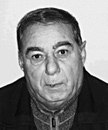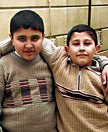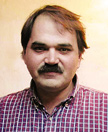|

Autumn 2004 (12.4)
 Contributors Contributors
 |
Curiosity,
hard work and a deep love for history and culture has brought
Anna Oldfield Senarslan to Baku as a U.S. Fulbright Scholar to
pursue her PhD. Her area of study: the age-old tradition of ashug
music - improvised poetry accompanied on the stringed instrument
saz. Specifically, Anna wondered if there were women ashugs in
this region of the world. She has since discovered an abundance
of them in Azerbaijan. In the meantime, her four-year-old son
Atilla has become fascinated with the music and recently told
his mom that when he grows up, he wants to be "the first
Azerbaijani-American ashug fireman ever!" See pages
62. |
 |
Probably
few fellow writers knew the late Mammad Araz (1933 - 2005) more
profoundly than Akram Aylisli. Both of them came from the countryside
to study in Baku. Both dedicated their lives to literature. Mammad
chose poetry, Akram chose the novel. Here Akram Aylisli shares
his thoughts about one of Azerbaijan's most well-known contemporary
writers, whose poems used to be sung like anthems during demonstrations
of the liberation movement against the Soviet Union in the late
1980s. Page 22. |
 |
Constance
Page is a founding member of the new athletic association called
the Baku Bicycle Club (BBC). Its members thrive on vigorous exercise,
while enjoying spectacular views of the Caucasus and Caspian
from heights and sites never viewed by bikers before. Serious
bikers usually own two bikes - road (thin tires) and mountain
(nubby, thick tires). No wonder they can't wait for Sundays when
road traffic is less daunting. They've also succeeded in raising
funds to install a lighting system at Baku's Velodrome so that
Azerbaijan's professional racers can prepare for competitions
at night. Page 78. |
 |
Don't
forget the kids when you want to understand the folklore of a
nation. Their games, riddles, tongue twisters are very much a
part of the fabric of folklore. Lucky us that brothers Mirislam
and Mirramiz Yunusov so enthusiastically helped us understand
the nature of "counting-out rhymes" in Baku's Old City
where they live. Counting-out rhymes are more than just words.
They reflect children's love of language - rhyme, rhythm and
alliteration. Mirislam is even creating some rhymes of his own.
Page 50. |
 |
Tofig
Gazanfar is a professional artist who studied in Baku and Leningrad.Often
the subject of his paintings and pastels seems very simple. The
layers of nuance appear in his pallette of colors and his shadings.
We thought both his subject matter and his approach would particularly
enhance our issue on Folklore.
Tofig describes painting as a vital part of his life. "It's
as essential to me as air and water. Not to be able to draw would
be like not living." If you want to see more of his work,
visit AZgallery.org.
His works are even more vivid in life, visit his studio close
to Baku Soveti Metro in downtown Baku. Contact: Mobile: (994-50)
647-6928. Page 36-43,
47. |
Back to Index AI 12.4 (Winter
2004)
AI Home
| Search | Magazine
Choice
| Topics
| AI Store | Contact us
Other Web sites
created by Azerbaijan International
AZgallery.org | AZERI.org | HAJIBEYOV.com
|